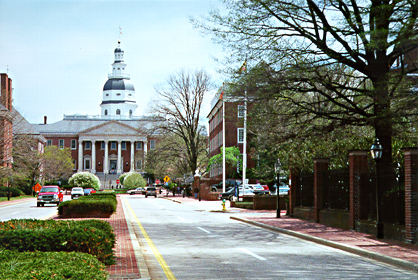
Executive Branch |
Legislative Branch |
Judicial Branch |
Maryland, on April 28, 1788, became the seventh state to ratify the federal Constitution.
Executive Branch. The Governor is the chief executive of the State. Elected by the voters to a four-year term, the Governor presides over the Governor's Executive Council. Known as the cabinet, the Council includes the heads of the eighteen departments which oversee most State government agencies.
Legislative Branch. The General Assembly, Maryland's bicameral legislature, consists of the Senate, led by the Senate President, and the House of Delegates, led by the House Speaker. As of January 2000, the 47-member Senate has 33 Democrats and 14 Republicans. As of the same date, the 141-member House of Delegates includes 106 Democrats and 35 Republicans.
Annually, the General Assembly convenes to enact laws on the second Wednesday in January for a 90-day session. In 2001, the General Assembly will convene its 415th session on January 10.
Judicial Branch. The Judiciary is headed by the Chief Judge of the Court of Appeals. Four court divisions make up the Judicial Branch: the Court of Appeals, the Court of Special Appeals, the Circuit Courts, and the District Court of Maryland.
© Copyright Maryland State Archives
LOCAL GOVERNMENT
Local Government. Of the 50 states, Maryland is among those with the fewest number of local governments. Local government is found in Maryland's 23 counties; 157 towns and cities (including Baltimore City); and special taxing districts, which are created by State, county and municipal governments.
Maryland Constitution
Maryland Elections
Maryland State Government Budget
Maryland State Seal
Maryland Departments
Maryland Constitutional Offices & Agencies
Maryland Independent Agencies
Maryland Executive Commissions, Committees, Task Forces, & Advisory Boards
Maryland Counties
Maryland Municipalities
Maryland at a Glance
Maryland Manual On-Line
Search the Manual
e-mail: mdmanual@mdarchives.state.md.us